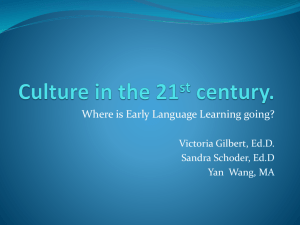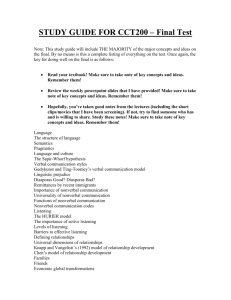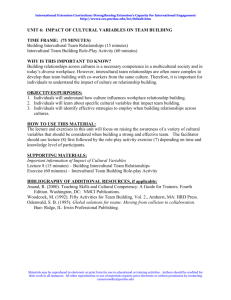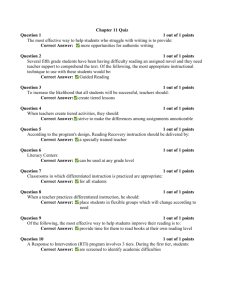National Network for Early Language Learning
advertisement
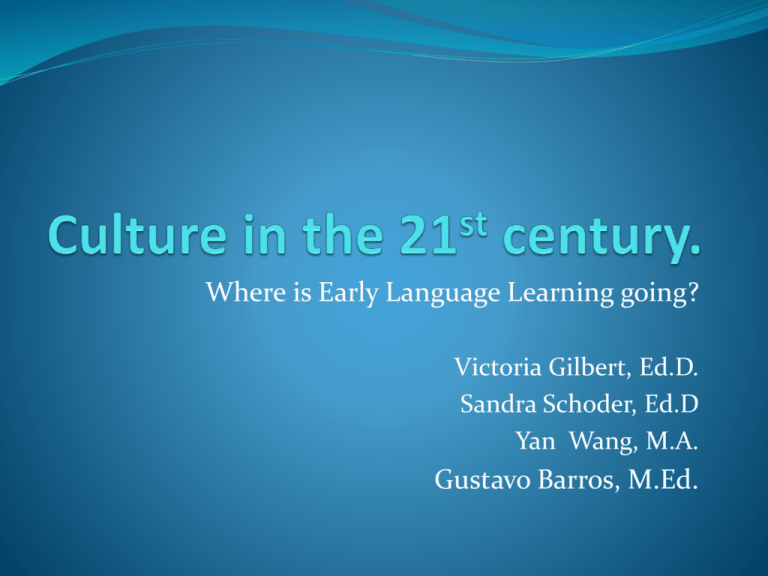
Where is Early Language Learning going? Victoria Gilbert, Ed.D. Sandra Schoder, Ed.D Yan Wang, M.A. Gustavo Barros, M.Ed. Proposal for a new web based resource by the NNELL culture committee contributors – Cheryl Berman, Kathy Duran, Victoria Gilbert, Akiyo Hirose, Sandra Schoder, Yan Wang Mission The NNELL Culture Committee acknowledges culture as the fundamental context for learning a language. Cultural sensitivity, cultural literacy, and intercultural competence are an integral part of learning a new language. The youngest learners do not learn language in isolation from culture, rather through meaningful experiences with the language. Thus, this committee’s mission is to examine ways to teach culture in the world language classroom and share best practices. · Goals Support teaching experience Provide a teacher development tool Offering a platform for sharing resources, strategies, and perspectives Promoting understanding through cultural activities for and of children around the globe Spreading the spirit of cultural diversity through understanding A collaborative, creative, and team-spirited approach to cultural understanding Early Language Learning and Teaching • Cultural responsive teaching • Differentiated Instruction • …. Instructional Methods Language Learning • Skills • Speaking • Listening • Writing • Reading • Culture(s) • What is culture? • “Big C” & “Little c” • Cultural and intercultural understanding and literacy Language Proficiency What is Culture? "Culture: learned and shared human patterns or models for living; day- to-day living patterns. These patterns and models pervade all aspects of human social interaction. Culture is mankind's primary adaptive mechanism" (p. 367). Damen, L. (1987). Culture Learning: The Fifth Dimension on the Language Classroom. Reading, MA: Addison-Wesley. Culture is defined as the shared patterns of behaviors and interactions, cognitive constructs, and affective understanding that are learned through a process of socialization. These shared patterns identify the members of a culture group while also distinguishing those of another group. CARLA’s Definition What is Culture? Teacher comes in with an explorer hat and hand lens, looks over a map of the country in question—tells students they are going to study the people… Teacher uses clown size large sunglasses decorated with flags and images of the target country to represent “looking at the world” through different eyes. Make “Culture” posters—have students work in groups with images you provide or they research to assemble significant aspects of culture you are studying. (works as an assessment and educational tool). Early Language Learning and Teaching • Cultural responsive teaching • Differentiated Instruction • …. Instructional Methods Language Learning • Skills • Speaking • Listening • Writing • Reading • Culture(s) • What is culture? • “Big C” & “Little c” • Cultural and intercultural understanding and literacy Language Proficiency ACTFL Standards for Foreign Language Learning Cultures: Gain Knowledge and Understanding of other cultures Standard 2.1 Students demonstrate and understanding of the relationship between the practices and perspectives of the culture studied Standard 2.2 Students demonstrate an understanding of the relationship between the products and perspectives of the culture studied Target Culture: Perspectives Why? The Culture Triangle Practices Products How? What? http://www.cortland.edu/flteach/lessons/culture-model-big.html Target Culture: Use a small trunk packed full with enough kitschy mementos, postcards, subway maps, whatever you can obtain as authentic representatives of the target culture (1 item for each child in class to hold and describe). Laminated images or clay can also be customized to represent specific objects that may otherwise be hard to come by. Have students pick one each as you pass the trunk around and describe something about it. You can create a slide show where actual object appears. Imaginary journey—use music, sound tracks of markets or other social gatherings, smells typical of environment, and “travel” to that location- (make taxi, airport, train, bus noises, etc.) have short encounter and return home. Early Language Learning and Teaching • Cultural responsive teaching • Differentiated Instruction • …. Instructional Methods Language Learning • Skills • Speaking • Listening • Writing • Reading • Culture(s) • What is culture? • “Big C” & “Little c” • Cultural and intercultural understanding and literacy Language Proficiency Culturally Responsive Teaching & Diversity: Tomlinson, understanding and recognizing the importance of addressing cultural and linguistic diversity, continued, You can only care for the child when you understand—what it is like to be part of that child’s culture, what it is like to be unable to speak the language of the classroom, what it is like to go home to a shelter every night . . . you can only do that [connect with learners’ interests] when you know what they care about, what they do that gives them joy, what they would wish for if they dared. (p. 67) Practical applications include giving students a chance to select how they demonstrate their mastery e.g. (song, poem, poster/ad, scenario/dialogue, ppt., gestural dance, etc.) Finding out about students’ home culture and making connections to that… particularly if there is a linguistic connection, e.g. Puerto Rican or Mexican student studying Spanish—be inclusive of different regional names for an object such as el autobús, la guagua, el camión) Early Language Learning and Teaching • Cultural responsive teaching • Differentiated Instruction • …. Instructional Methods Language Learning • Skills • Speaking • Listening • Writing • Reading • Culture(s) • What is culture? • “Big C” & “Little c” • Cultural and intercultural understanding and literacy Language Proficiency Cultural and Intercultural Understanding and Literacy Age-appropriate analysis of intercultural differences and commonalities Select a situation, such as what do you say when someone sneezes, burps, or is introduced. Use a puppet or heritage speaker to model, practice vocabulary needed in whole groups, then ask students to practice in pairs while teacher circulates to monitor. Sometimes just directionality of text can be important literacy skill—bring in street signs, newspaper, or ads that represent how one would have to read text… have students use fingers to indicate motion when you ask them to “read”. Survival video http://www.youtube.com/watch?v=mzEjzL6_gyE Early Language Learning and Teaching • Cultural responsive teaching • Differentiated Instruction • …. Instructional Methods Language Learning • Skills • Speaking • Listening • Writing • Reading • Culture(s) • What is culture? • “Big C” & “Little c” • Cultural and intercultural understanding and literacy Language Proficiency Your input- Suggestions Feedback Join the committee Submit an article or lesson plan Thank you– your culture bank is what you make of it!
